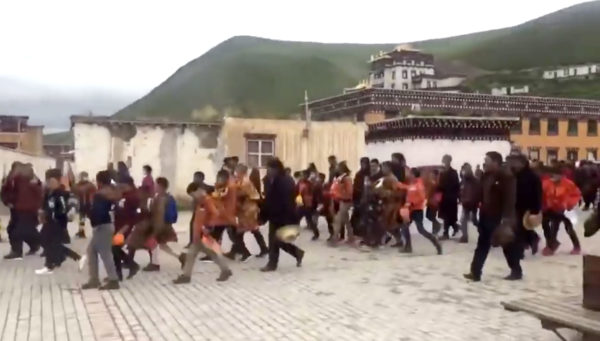
Young Tibetan monks were compelled to leave one of the biggest monasteries in the eastern Tibetan area of Kham, Sershul, this week as part of a drive by the Chinese government to replace monastic education with secular schooling that emphasizes Communist Party propaganda.
Images circulating in the last few days on social media show a large group of boys in lay clothing accompanied by monks leaving Sershul monastery in Kardze (Chinese: Ganzi) Tibetan Autonomous Prefecture, Sichuan. According to reports from Tibetan sources, young monks in smaller monasteries in the area have been targeted as part of the same push for the ‘Sinicization’ of Tibetan Buddhism and political education in schools.
Traditionally in Tibet, monks entered monasteries, which are important centers of culture and education, as novices at a young age. While Communist Party work teams first began preventing young monks from joining monasteries in the mid-1990s, the level of enforcement has varied from monastery to monastery. According to the International Campaign for Tibet’s sources, the effort at Sershul to compel young monks to join government-run secular schools is happening in other Tibetan areas, including areas in Qinghai, and is of deep concern to Tibetans.
A former monk from Labrang monastery in Amdo, who is now in exile, said: “In Tibetan monasteries, young monks are raised to be protectors of their own culture and Buddhist values from a young age. And then when they grow up, they pass on their education to a young monk, so it goes full circle. I learned from older monks at my monastery, and when I was in my early thirties, I then taught the young monks, not only about the scriptures and studying, but also how to do their homework, how to behave, and how to do practical tasks such as fetching water and cleaning. When young monks are forced to leave the monasteries, this vital connection between generations is broken, and they will be subjected to Party propaganda from a young age. So the implications of what has happened at Sershul are very worrying.”
The developments at Sershul (Chinese: Shiqu) county, the largest Gelugpa monastery in the Tibetan area of Kham, are evidence of the new, tougher phase in the Chinese Communist Party’s broader efforts to control Tibet by replacing loyalty to the Dalai Lama with allegiance to Party policy. The Chinese authorities are seeking to influence a new generation growing up in Tibet, and to mold and shape Tibetan Buddhism to the dictates of the Communist Party in line with a more deeply entrenched regulatory framework that has already increased religious oppression over the last decade. China’s revised religious regulations, issued last September, consolidate the Communist Party’s far reaching power over people’s lives and beliefs.[1]
Tibetan sources said that parents of children required to leave Sershul monastery and monks were told that if they refused, the monastery would be closed.
Founded in 1760, Sershul is a large monastery of great historic and religious significance, famous for its scholarship.[2] It contains relics linked to Nalanda monastery in India, whose teachings were famously preserved by Tibetan masters, and has an Institute for Higher Buddhist Studies, making it the only monastic university in the Kham region that is qualified to teach and bestow the highest Tibetan Buddhist ‘Geshe’ degree.
Chinese authorities increasingly aim to undermine and supplant the Tibetan religious hierarchy and weaken the authority of legitimate Tibetan religious leaders both inside and outside Tibet, including monks with Geshe degrees. In Lithang (Chinese: Litang), another area of Kham, a recent ruling stated that only monks who had received the People’s Republic of China-administered version of the Geshe degree would be allowed to teach Buddhism in the area. Tibetan sources have confirmed that the Chinese authorities have been imposing the same restrictions elsewhere, including at the important and influential monastery of Labrang Tashikyil in the Tibetan area of Amdo, present-day Gansu Province. Monks who studied in India, and who had the opportunity to attend teachings by the Dalai Lama, have long been unable to teach in monasteries in the Tibet Autonomous Region.[3]
Footnotes:
[1] International Campaign for Tibet report, ‘China’s revised religious regulations threaten survival of Tibetan Buddhism’, September 18, 2017, https://www.savetibet.org/chinas-revised-religious-regulations-threaten-survival-of-tibetan-buddhism/
[2] For a video of the monastery with English subtitles, see the Kham Film Project at: http://www.khamfilmproject.org/sershul-tib/
[3] International Campaign for Tibet report, ‘Monks who studied in India banned from teaching in Tibet; new ruling bans schoolchildren from religious activity’, May 17, 2018, https://www.savetibet.org/monks-who-studied-in-india-banned-from-teaching-in-tibet-new-ruling-bans-schoolchildren-from-religious-activity/